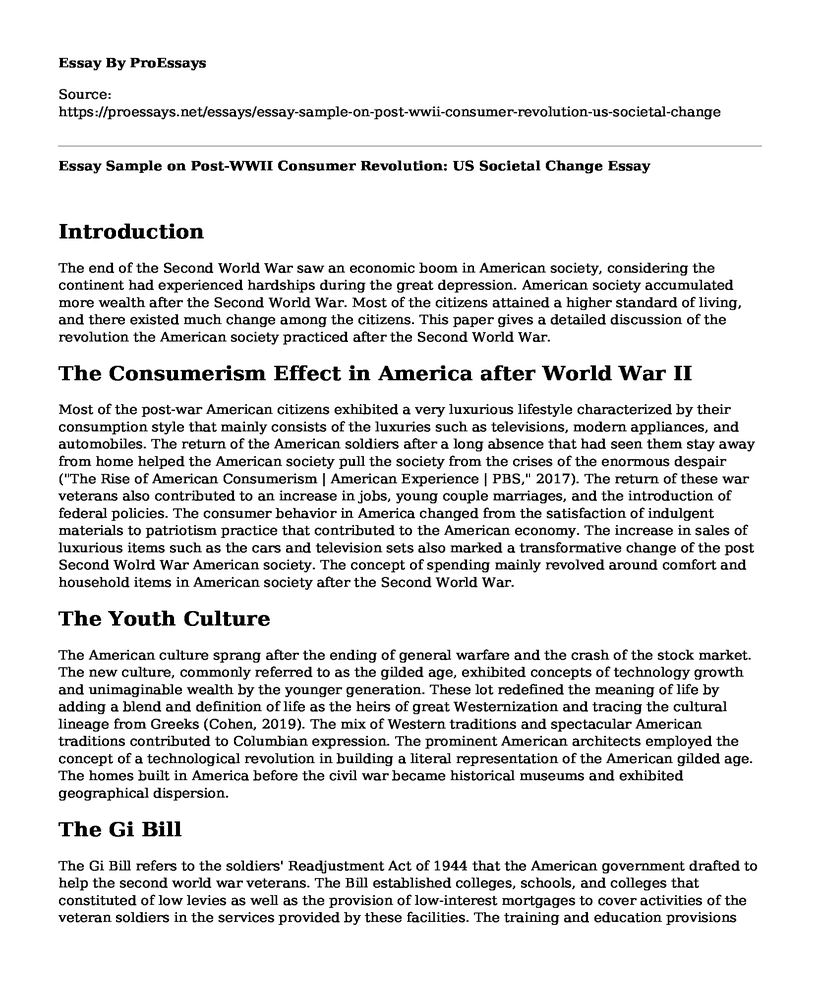Introduction
The end of the Second World War saw an economic boom in American society, considering the continent had experienced hardships during the great depression. American society accumulated more wealth after the Second World War. Most of the citizens attained a higher standard of living, and there existed much change among the citizens. This paper gives a detailed discussion of the revolution the American society practiced after the Second World War.
The Consumerism Effect in America after World War II
Most of the post-war American citizens exhibited a very luxurious lifestyle characterized by their consumption style that mainly consists of the luxuries such as televisions, modern appliances, and automobiles. The return of the American soldiers after a long absence that had seen them stay away from home helped the American society pull the society from the crises of the enormous despair ("The Rise of American Consumerism | American Experience | PBS," 2017). The return of these war veterans also contributed to an increase in jobs, young couple marriages, and the introduction of federal policies. The consumer behavior in America changed from the satisfaction of indulgent materials to patriotism practice that contributed to the American economy. The increase in sales of luxurious items such as the cars and television sets also marked a transformative change of the post Second Wolrd War American society. The concept of spending mainly revolved around comfort and household items in American society after the Second World War.
The Youth Culture
The American culture sprang after the ending of general warfare and the crash of the stock market. The new culture, commonly referred to as the gilded age, exhibited concepts of technology growth and unimaginable wealth by the younger generation. These lot redefined the meaning of life by adding a blend and definition of life as the heirs of great Westernization and tracing the cultural lineage from Greeks (Cohen, 2019). The mix of Western traditions and spectacular American traditions contributed to Columbian expression. The prominent American architects employed the concept of a technological revolution in building a literal representation of the American gilded age. The homes built in America before the civil war became historical museums and exhibited geographical dispersion.
The Gi Bill
The Gi Bill refers to the soldiers' Readjustment Act of 1944 that the American government drafted to help the second world war veterans. The Bill established colleges, schools, and colleges that constituted of low levies as well as the provision of low-interest mortgages to cover activities of the veteran soldiers in the services provided by these facilities. The training and education provisions existed until 1956("G.I. Bill," 2019). The Bill continues to extend the concept of training and education to veteran soldiers and currently includes the soldiers who served during the peace times. The Gi Bill continues to exist today by giving soldiers who serve for 90 days a chance to further their studies.
Suburbanization Impact on American Society After World War II
The growth of the American suburbs after World War II resulted from the immediate effect of numerous innovations in the automobile industry and the redlining effect that led to the segregation and decline of the inner-city neighborhood ("Culture of Abundance | Boundless U.S. History," 2018). The suburb's population in the northern part of America increased as a result of war veterans returning and starting a life in the suburbs and more masses moving from the town centers. The zoning laws also led to the creation of residential areas outside the cities hence contributing to growth suburbs. The suburban dwellers built on large plots compared to the inner city.
Role of Religion in Post-Second World War II American Society
Religion fueled the Second World War through Hitler's desire to reform Christianity and satisfy his selfish desires to conquer the globe. The leader desired to create an Aryan society composed of pure Germans and excluding the Jewish people (Reynonds, 2018). These desires heightened the need to defeat Hitler's rule and save the civilized norms of societies.
Conclusion
The prosperity of post-war American society contributed to an increase in birth rates and the pushing of females to domestic gender, which coincided with the rise in structured religious inclination. World War II contributed to the growth and development of American society, contrary to the effect of the war in any nation.
References
Cohen, P. (2019). Gilded Age. Retrieved from https://flaglermuseum.us/history/gilded-age
Culture of Abundance | Boundless U.S. History. (2018). Retrieved from https://courses.lumenlearning.com/boundless-ushistory/chapter/culture-of-abundance
G.I. Bill. (2019). Retrieved from https://www.history.com/topics/world-war-ii/gi-bill
The Rise of American Consumerism | American Experience | PBS. (2017). Retrieved from https://www.pbs.org/wgbh/americanexperience/features/tupperware-consumer
Reynolds, D. (2018). What role did religion play in WWII?. Retrieved from https://www.enotes.com/homework-help/what-role-did-religion-play-wwii-1193861
Cite this page
Essay Sample on Post-WWII Consumer Revolution: US Societal Change. (2023, Mar 26). Retrieved from https://proessays.net/essays/essay-sample-on-post-wwii-consumer-revolution-us-societal-change
If you are the original author of this essay and no longer wish to have it published on the ProEssays website, please click below to request its removal:
- Essay Example on 15th Century Marriage: Bringing People Together
- Research Paper on Holocaust: Systematic Murder, Persecution & Loss of Liberty
- Essay Sample on Creating Safe Spaces: Exploring Eli Clare's Activism for Queer and Disabled People
- Indigenous Community Welfare: Impact & Development - Essay Sample
- The Effectiveness of Proactive Crisis Communication Strategies - Essay Sample
- Conflict Between US Govt & Military: Problems Since Rev War - Essay Sample
- Free Report Example on Exploring Dual-Income Families







